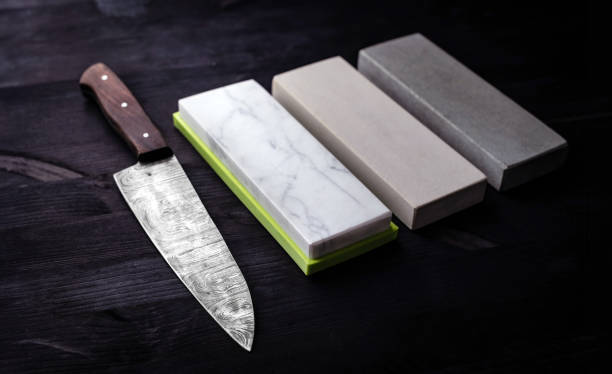How to Sharpen a Knife: Tools, Techniques, and Maintenance
2025 May 12th
When it comes to kitchen tools, the knife is undoubtedly one of the most important. We believe that a sharp knife is an absolute essential for every home cook. A sharp knife isn’t just convenient, it’s essential for safety, efficiency, and the longevity of your knife. Using a dull blade can lead to accidents, longer prep times, and uneven cuts, which can affect the quality of your food. Regular sharpening keeps your knife performing at its best, making it safer and easier to use.
While sharpening knives isn't something you do every day, we believe that knowing a few simple tricks can make a big difference! In this guide, we'll walk you through the proper way to sharpen a knife, so you can enjoy a smoother cooking experience and maintain your knives in top-notch condition.
What Does Sharpening a Knife Involve?
When we talk about knife maintenance, it’s important to understand the difference between sharpening and honing. While these two terms are often used interchangeably, they actually refer to two distinct processes that are both necessary for maintaining a sharp knife.
Sharpening a knife involves removing a small amount of material from the blade to create a new, sharper edge. Over time, the edge of your knife becomes dull due to regular use, which means it no longer cuts as effectively. Sharpening helps to restore that sharp edge by grinding the blade, often using tools like a whetstone or diamond sharpener.
On the other hand, honing doesn’t remove material from the blade. Instead, it realigns the edge of the knife, straightening any microscopic bends or curls that occur with use. Honing helps maintain your knife’s edge between sharpenings and is best done regularly, using tools like a honing steel or honing rod.
Some kitchen knives, especially premium brands like Shun, Global Knives, Zwilling and Wüsthof, are designed to hold an incredibly sharp edge from the start. These knives are made with high-quality steel and superior craftsmanship, making them well worth the effort to maintain. It would be a shame not to take proper care of them! Regular sharpening and honing ensure that knives like these continue to perform at their best for years to come.
So when should you sharpen your knives? You’ll know it’s time when you start to notice that your knives are no longer cutting as easily. If you find yourself struggling to slice through vegetables or meat, or if you need to apply excessive force to make a cut, that’s a clear sign that your blade is dull and in need of sharpening!
Tools You’ll Need to Sharpen a Knife
Having the right tools for sharpening can really make a difference. Regular sharpening with the best knife sharpeners, whether electric, manual, sharpening stones or other tools, ensures that your knives stay in top condition. Here’s a rundown of the essential tools you’ll need to restore your knives to a sharp and ready to use edge:
| Tool/Method | Description | Best For | Frequency |
|---|---|---|---|
| Whetstone | A stone used for grinding and sharpening the blade. | Restoring a sharp edge | Every 6-12 months |
| Manual Sharpeners | Simple, user-friendly tools for quick sharpening. | Beginners or quick touch-ups | As needed |
| Electric Sharpeners | Automated sharpeners for fast and easy results. | Those who want speed and convenience | As needed |
| Honing Rod | A rod that realigns the knife’s edge between sharpenings. | Maintaining the edge between sharpenings | Weekly or as needed |
| Lubricants (Water/Oil) | Used with sharpening stones to reduce friction. | Enhancing the sharpening process | Each time you sharpen |
- Sharpening stones: Whetstones are a favorite among many home cooks and professionals alike. They come in different grits, which refer to the level of coarseness or fineness of the stone. Coarse grits (around 200-400) are ideal for repairing dull or damaged blades, as they help to remove larger amounts of material. Medium grits (around 800-1000) are great for regular maintenance and refining the edge. Finally, fine grits (above 3000) are used for polishing the blade and achieving a smooth, sharp edge. A good whetstone is all you need for a complete sharpening job.

- Electric Sharpeners and Manual Sharpening Tools: If you prefer a more automated approach, electric sharpeners are a convenient choice. They work quickly and can be a good option if you’re short on time or prefer a simple solution. On the other hand, manual sharpening tools, such as pull-through sharpeners, offer more control and a hands-on approach. While they’re not as versatile as whetstones, they can still get the job done for a quick touch-up.
- Lubricants (Water or Oil for Sharpening Stones): To get the best results from your whetstone, you’ll need to use a lubricant. Most whetstones require either water or oil to keep the stone from clogging with metal particles and to help the blade glide smoothly across the surface. Water stones are the most common, as they’re easy to use and clean, while oil stones require honing oil, which can provide a smoother finish but is a bit messier to work with.
Honing Rods: Honing rods, also known as honing steels, are essential tools for maintaining your knife’s edge between sharpenings. They come in different materials, with steel and ceramic being the most common. A honing rod helps straighten any microscopic bends in the blade, keeping your knife sharp for longer. While honing doesn’t remove material like sharpening does, it helps maintain the edge by realigning it. Using a honing rod regularly can keep your knives in good shape, reducing the need for frequent sharpening. - Angle Guide (Optional): If you’re new to sharpening or want to make sure you’re keeping the right angle, an angle guide can be a helpful addition to your toolkit. This tool helps maintain a consistent angle while sharpening, making the process easier and more accurate, especially if you're working with different types of knives.

With the right tools at hand, you’ll be ready to sharpen your knife and maintain that sharp edge for all your cooking needs!
Step-by-Step Guide to Sharpen a Knife
Now that you have the right tools and a basic understanding of knife sharpening, let’s dive into the actual process. Follow this simple, step-by-step guide, and you’ll have your knife back to a sharp, efficient edge in no time!
1. Prepare the Tool
Before you start, it’s important to get your tools ready. If you’re using a whetstone, make sure to soak it in water for about 10-15 minutes before use. This will help prevent the stone from drying out and ensure smoother sharpening. If you’re using another tool, like a honing rod or manual sharpener, just make sure it’s clean and ready to go.
2. Set the Correct Angle
Setting the right angle is key to sharpening your knife effectively. The angle you choose depends on your kitchen knives. For Western knives, the most common angle is 20°, while Japanese knives typically require a slightly finer angle of 15°. You can use an angle guide to help you maintain the correct position as you work. Keeping the right angle ensures that you get a sharp edge without damaging the blade.
3. Sharpen One Side
Now it’s time to start sharpening! Place the knife on the whetstone and use a sweeping motion as you slide the blade across the surface. Apply consistent, even pressure, not too heavy, but firm enough to maintain contact with the stone. It’s important to keep the angle steady and use long, sweeping strokes along the length of the blade, making sure you cover the entire edge. This process removes the dull edge and starts to form a new, sharp edge.
4. Switch to the Other Side
Once you've sharpened one side of the blade, it’s time to switch to the other. Turn the knife over and repeat the same process on the opposite side. This ensures that both sides of the blade are evenly sharpened, creating a balanced, sharp edge.
5. Polish the Edge
After you've sharpened both sides, it’s time to polish the edge. Using a finer grit whetstone or a strop, gently refine the blade to achieve a smooth, razor-sharp finish. This step removes any remaining burrs and gives your knife a fine, polished edge that will glide through food effortlessly.
6. Hone the Blade
The final step is honing. After sharpening, you should always hone your knife to realign the edge. Use a honing steel or a honing rod to gently straighten the blade. This ensures the edge stays aligned and sharp for longer, reducing the need for frequent sharpening. It’s a small but important step in maintaining the sharpness of your knife.
And there you have it! With these simple steps, your knife will be back to its sharpest, most efficient self.
Common Mistakes to Avoid
While sharpening your knife is a simple process, it’s easy to make mistakes that can affect the quality of the edge and even damage your blade. To help you sharpen like a pro, here are some common mistakes you’ll want to avoid:
1. Over-Sharpening and Removing Too Much Metal
Sharpening your knife is about maintaining the edge, not drastically reshaping it. Over-sharpening can remove too much metal, leading to a thinner, weaker blade that’s more prone to damage. Be mindful of how much you’re grinding off and avoid excessive sharpening, especially if your knife is still in decent condition.
2. Using Incorrect Angles
As we mentioned earlier, setting the right angle is crucial for effective sharpening. Setting the right angle is essential for sharpening your knife effectively. If the angle is too steep or too shallow, you won’t achieve the desired sharpness and could even damage the blade. Make sure to adjust your sharpening technique based on the type of knife you’re working with.
3. Applying Too Much Pressure
It might seem like pressing hard will give you a sharper blade faster, but applying too much pressure can actually ruin the edge and make the process less effective. Light, consistent pressure is the key to sharpening. Let the tool and the stone do the work, and don’t force it.
4. Neglecting to Clean and Dry Tools
After sharpening, make sure to clean and dry your tools thoroughly. Leftover metal particles can affect the next sharpening process and make the tools less effective.
We suggest avoiding these common mistakes, as in the end, it's all about mastering the technique and keeping your knives sharp and ready for whatever culinary challenge comes your way!
How to Maintain a Sharp Knife (Our Chef’s Piece of Advice)
Maintaining a sharp knife goes beyond simply sharpening it every now and then; it requires regular care and good habits. To keep your blade in top shape, it's important to incorporate a few essential practices into your routine.
First, honing your knife with a honing rod after every few uses is crucial, it helps maintain its edge and reduces the need for frequent sharpening.
When storing your knives, always choose magnetic holders or knife blocks to prevent any damage or dulling. Throwing knives in a drawer can lead to unwanted nicks.
Cleaning your knives properly is also essential, always hand wash them with warm, soapy water and dry them right away.
Dishwashers should be avoided, as they can damage both the blade and the handle. Lastly, make sure to use the right cutting board. Hard surfaces like glass or stone can dull your knife, so stick with wooden or plastic cutting boards to help preserve its sharpness. By following these simple practices, your knives will stay sharp and ready for any culinary task.
FAQs About Sharpening Knives
We know there’s a lot to consider when it comes to sharpening knives! This quick FAQ section helps clarify some of the most common concerns and provide extra tips to make sure you’re on the right track:
How often should you sharpen your knives?
The frequency of sharpening depends on how often you use your knives and what kind of tasks they perform. As a general rule, if you're using your knife regularly, you may need to sharpen it every 6-12 months. However, honing regularly between sharpening sessions can extend the time between actual sharpenings.
Can you sharpen serrated knives?
Yes, serrated knives can be sharpened, but they require a different technique. Instead of using a whetstone, you’ll need a ceramic rod or a special serrated knife sharpener to maintain the sharpness of the individual teeth. It’s best to sharpen serrated knives by hand to ensure you don’t damage the serrations.
What’s the best sharpening method for beginners?
For beginners, we suggest starting with a manual sharpener or a pull-through sharpener. These tools are user friendly, affordable, and don’t require much skill or experience. If you're ready to dive deeper, using a whetstone with an angle guide can provide more control and a finer edge as you become more comfortable with sharpening techniques.
Can I sharpen my knife with a honing rod?
While a honing rod doesn’t technically sharpen a blade, it helps maintain the edge and can realign the knife to keep it sharper for longer. It’s a great tool for touch-ups and should be used regularly to prevent the need for frequent sharpening.
How do I know if my knife needs sharpening?
You’ll know it’s time to sharpen your knife when it starts to feel dull or you have trouble cutting through food easily. If your knife starts to “tear” rather than slice, or if you need to apply excessive force to make a cut, those are clear signs that the blade needs sharpening.
Come Visit Us: Sharpening for a Cause
If you're located in Ontario or within driving distance, we’d love to welcome you to our store at 2150 Ambassador Drive. Each month, we host Sharpening for a Cause, a special initiative where 100% of the proceeds from our knife sharpening services are donated to a different local charity or community project.
It’s a great opportunity to keep your kitchen tools in top shape while giving back to those in need. Whether you’re a home cook, a culinary student, or a seasoned chef, stop by, bring your knives, and be part of something meaningful one sharpening at a time!

Conclusion: Keep It Sharp!
Sharpening your knives doesn’t have to be complicated, but it does require the right tools and techniques. By following the right steps, avoiding common mistakes, and maintaining good practices like honing regularly and storing your knives properly, you’ll ensure your knives stay sharp and ready to perform at their best. Happy sharpening!




